Abstract
The name Cistanche tubulosa s.l. is used from Africa and the Middle East to South and Central Asia and China, however this name is applied to plants that have been shown to comprise a polyphyletic group. Maintaining the use of this species name across distinct lineages is untenable, but inclusion of a type specimen in further analyses is needed to correctly apply names to revised taxa and to evaluate the recent decision to place the name in synonymy under the name C. tinctoria (Forssk.) Beck. Therefore, we proposed a neotype for Cistanche tubulosa (Schenk) Wight ex Hook.f. We contextualise the relevant taxonomy with a broader discussion on taxonomic challenges in the genus Cistanche in which several species are traded for herbal medicine, rare, or are of conservation concern.
References
- Aitchison, J.E.T. (1888) The botany of the Afghan Delimitation Commission. Transactions of the Linnean Society of London, 2nd series. pp. 94. https://doi.org/10.1111/j.1095-8339.1888.tb00623.x
- Ataei, N. (2017) Molecular systematics and evolution of the non-photosynthetic parasitic Cistanche (Orobanchaceae). Universitats-und Landesbibliothek, Bonn.
- Ataei, N., Schneeweiss, G.M., Garcia, M.A., Krug, M., Lehnert, M., Valizadeh, J. & Quandt, D. (2020) A multilocus phylogeny of the non-photosynthetic parasitic plant Cistanche (Orobanchaceae) refutes current taxonomy and identifies four major morphologically distinct clades. Molecular Phylogenetics and Evolution 151: 106898. https://doi.org/10.1016/j.ympev.2020.106898
- Beck-Mannagetta, G. (1930) Orobanchaceae. In: ENGLER, A. (ed.) Das Pflanzenreich, vol. 4 (261). pp. 1–348.
- Desfontaines, R.L. (1798) Flora atlantica vol. 2: sive historia plantarum quae in Atlante, agro tunetano et algeriensi crescunt. Parisiis: L.G. Desgranges. https://doi.org/10.5962/bhl.title.323
- Forsskal, P. (1775) Flora Aegyptiaco-Arabica. ex officina Molleri. Copenhagen.
- Hoffmannsegg, J.C. & Link, H.F. (1813) Flore Portugaise, ou description de toutes les plantes qui croissent naturellement en Portugal. Fr. and Lat. tom. I. L.P. Berlin : de l’imprimerie de Charles Fréderic Amelang et se trouve chez les auteurs, Kronenstrasse, pp. 318–320.
- Hooker, J.D. (1875) The Flora of British India. L. Reeve & Co., London. https://doi.org/10.5962/bhl.title.678
- Lei, D., Thorogood, C.J., Tu, P., Song, Y., Huang, L., Aldughayman, M., Leon, C.J. & Hawkins, J.A. (2021) 1002. CISTANCHE DESERTICOLA: Orobanchaceae. Curtis’s Botanical Magazine 38 (4): 472–486.
- Leon, C. & Lin, Y. (2017) Chinese medicinal plants, herbal drugs and substitutes: an identification guide. Kew Publishing, London.
- Moreno Moral, G., Sanchez Pedraja, O. & Piwowarczyk, R. (2017) Contributions to the knowledge of Cistanche (Orobanchaceae) in the Western Palearctic. Phyton (Horn) 57 (1/2): 19–36.
- Reuter, G.F. (1847) Orobanchaceae. In: De Candolle, A. (Ed.) Prodromus systematis naturales regni vegetabilis, vol. 11. Masson, Paris.
- Sanchez Pedraja, O., Moreno Moral, G., Carlon, L., Piwowarczyk, R., Lainz, M. & Schneeweiss, G.M. (2023) Index of Orobanchaceae. Available from: http://www.farmalierganes.com/Otrospdf/publica/Orobanchaceae%20Index.htm (accessed: 29 December 2023).
- Schenk, A. (1840) Plantarum species, quas in itinere per Aegyptum, Arabiam et Syriam cli. viri G. H. de Schubert, M. Erdl et J. R. Roth collegerunt. Monachii, Germany: Wolf.
- Stafleu, F.A.F.A. & Cowan, R.S. (1976) Taxonomic literature: a selective guide to botanical publications and collections with dates, commentaries and types (2d ed., Vol. v.5 (1985) [Authors Sal-Ste]). Bohn, Scheltema & Holkema. https://doi.org/10.5962/bhl.title.48631
- Thorogood, C.J., Leon, C.J., Lei, D., Aldughayman, M., Huang, L. f. & Hawkins, J.A. (2021) Desert hyacinths: An obscure solution to a global problem? Plants, People, Planet 3 (4): 302–307. https://doi.org/10.1002/ppp3.10215
- Wight, R. (1850) Icones plantarum Indiae Orientalis for figures of Indian plants (Vol. v.4). Published by J.B. Pharoah for the author, Madras.


